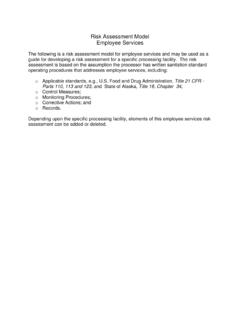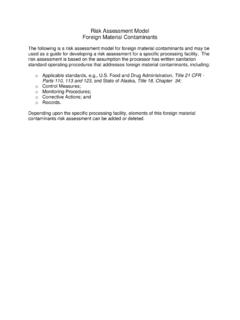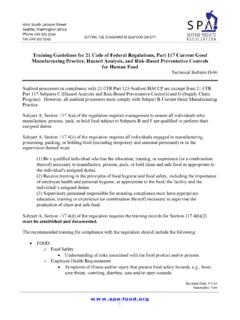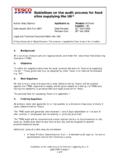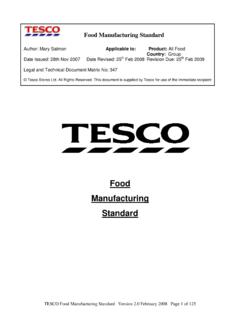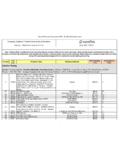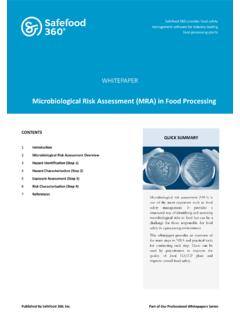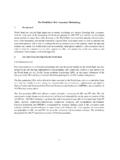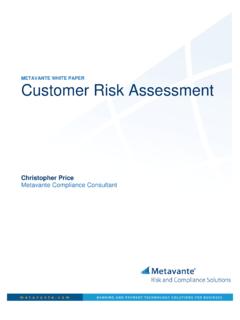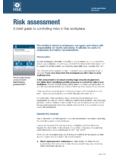Transcription of Risk Assessment Model Pest Control Procedures
1 Risk Assessment Model Pest Control Procedures The following is a risk Assessment Model for pest Control Procedures and may be used as a guide for developing a risk Assessment for a specific processing facility. The risk Assessment is based on the assumption the processor has written sanitation standard operating Procedures that addresses a pest Control program, including: o Applicable standards, , Food and Drug Administration, Title 21 CFR - Parts 110, 113 and 123, and State of Alaska, Title 18, Chapter 34; o Control Measures; o Monitoring Procedures ; o Corrective Actions; and o Records. Depending upon the specific processing facility, elements of this pest Control risk Assessment can be added or deleted. Risk Assessment Model Pest Control Procedures Risk Assessment - Potential Hazard Identification: Pests---including insects, rodents and birds---and other wild and domestic animals are a potential source of product adulterants in a food processing facility.
2 All pest ingress points must be eliminated and pests must be controlled and/or eliminated from the processing facility to prevent contamination of food, food contact surfaces, and packaging materials. Risk Assessment - Hazard Characterization: In most cases, pests may be considered a source of product adulterants rather than food safety hazards. However, pests can be potential sources of food safety hazards (pathogens) and/or disease. Insects, rodents and birds are common pests in nature and are attracted to food processing environments which provide a potential reliable source of food and water. In addition, wild and domesticated animals may also be attracted to the processing facility especially in remote areas. Pest ingress and Control are covered under Title 21, Code of Federal Regulations Part 110 - Good Manufacturing Practices regulation, including: Section (c) - Pests that states: No pests shall be allowed in any area of a food plant.
3 **Effective measures shall be taken to exclude pests from the processing areas and to protect against the contamination of food on the premises by pests. The use of insecticides or rodenticides is permitted only under precautions and restrictions that will protect against the contamination of food, food-contact surfaces, and food-packaging materials. Requirements to comply with the GMPs are also emphasized and/or monitored under the provisions of: o Seafood Products Association s Salmon Control Plan and Technical Bulletins; and o Title 21, Code of Federal Regulations 123 Fish and Fishery Products. The Control of pests in the processing facility depends upon the inspection of potential ingress points and elimination and/or Control of pests if they enter the facility. The frequency of inspection and the type of Control measures must consider the pest category and their habits, their presence in the area ( , remote or city), historical data, ingress security measures, and the good manufacturing practices.
4 Risk Assessment Model Pest Control Procedures Page No. 2 Completion and review of written records of the inspections is an essential component of monitoring the potential risk. Risk Assessment Exposure Assessment : All areas of the processing facility are potentially subject to the risk of pest ingress if not controlled, and all food, food contact surfaces and packaging materials may be exposed to pest contaminants once they enter the processing facility. Risk Assessment Risk Characterization: Severity High Contamination of Product and/or Raw Materials Medium Contamination of Food Contact Surfaces and/or Packaging Materials Low Not Likely to Gain Access to Processing Areas High Frequent, everyday occurrence High High Low Medium Occasional occurrence High Medium Low Likelihood of Pest On-Site Low Not known to exist in area Low Low Low Risk Assessment Model Pest Control Procedures Page No.
5 3 Pest Risk Flying Insects High Birds Medium Rodents Medium Bears and Other Wild Animals Low Domestic Animals Low Risk Management: Adherence to the pre-season inspection Procedures and inspections during the processing season should be sufficient to Control pests and mitigate the potential risk, provided: A comprehensive pre-season evaluation of the processing facility is conducted to identify all potential pest ingress points and repairs/corrective action taken when potential entry points are identified; During the season, inspections are conducted on a daily---or more frequency if deemed necessary---to identify new potential ingress points and/or evidence of pest activity; Repairs/corrective action is taken to remedy any new problems that are identified during the daily inspections; and Inspections are documented and the reports are reviewed by responsible management in a timely manner and, as warranted, trend analysis of pest activity is conducted.
6 Risk Assessment Model Pest Control Procedures Page No. 4 Risk Communication: Management must identify the personnel responsible for the implementing the pest Control program during the pre-season inspection and subsequently during the processing season, and communicate the significance of the pest Control program to the individuals. The need to follow all established written Procedures to prevent contamination of food, food contract surfaces and packaging materials must be emphasized to the designated responsible personnel. Record keeping requirements and Procedures also must also be communicated to the designated personnel responsible for the program.
